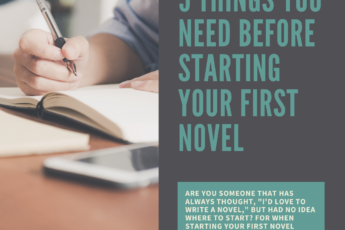Get an idea for the process I (usually) go through when it comes to planning a new book…
There are writers who plan, and those that don’t. I have given the latter a go in the past, and I can truthfully say it doesn’t work for me. It kinda goes against my programming. For me, planning a new book gives you an invaluable asset for the greater creative process. It serves as your log, your journal and your Bible for ideas, plot points, characters and everything else, really.
If you, as a writer, prefer to run with an idea and just see where it takes you, this post probably won’t be much use to you. But if you’re only just starting and think you could use a plan, I’ve reflected on the steps I take in planning a new book for you to follow.
1. Logline for the idea
It’s best if you know exactly what you’re writing about. Best way to get the main focus of your story is writing a logline. Essentially reducing your idea to one or two sentences. For example, You Can Hear Chopin from the Attic‘s is: A hotel manager in 1940s Germany must hide the existence of his schizophrenic wife from his Nazi Party clientele.
2. Cast your characters
Once you know the general premise, it’s time to plan the characters who will feature in the story. You can do this as a simple bulleted list with a couple of details. Or you can write profiles for each one, building on these as you go, including things such as physical description, personality, likes and dislikes, friends enemies and relatives, so on. I find that characters are the most changeable element of a story plan. The journey I set them on at the start can end up looking very different in the end product as we come to know the characters better.
3. Pinpoint your key story points
Okay, so you’ve got the basis for your story, and you’ve got the characters. Now it’s time to map out the course your story will take. Where your main characters are going to start, where they’re going to end up, and then key points of development in between. The inciting incident that sets the plot and the character development in motion. Pivotal points at which the characters’ relationships, psychologies, philosophies, etc. intensify, switch, or whatever else you can think of. Is there going to be a twist? If so, make sure that’s pinpointed. And of course, there’s things like climax, dénouement, resolution, and so on.
The number of key story points will depend entirely on the nature and complexity of your story. If you’re only following one main protagonist, you may find you only have to map out five or six points. For more expansive literary efforts that follow a number of characters, your story will have continuing series of peaks and troughs. And, like the rest of a plan, these points can be whittled down or outright changed as you write your story. Neither of The Berylford Scandals books ended as I had originally planned them. The same will be said for You Can Hear Chopin, from which I have decided to cut a substantial chunk from the end. So the ending point for many of the characters has shifted considerably.
4. Expand into a full synopsis
From those key story points, now you need to fill in the gaps. A synopsis is a summary of the full work. So this is where you can plot the events that drive your story and character development towards those key points. Here, you can note where relationships change, how events affect your characters and their decisions, and how emotions are shifting. By the end, you should have a more-or-less full map to follow for writing your book from start to finish.
I tend to go one step further when I’m planning a new book and do my synopsis by chapter. Main reason being, I usually follow several characters, so it’s important to know whose point-of-view we’re following, whose development we’re concerned with.
Again, this synopsis is not a set-in-stone part of the document. What seemed like the most natural or sensical thing to do during the planning stage may seem completely wrong when it comes to writing it. Just be mindful that if you deviate from your plan, it may affect the direction of the rest of your story.
5. Don’t forget your research
After I’ve finished my chapter-by-chapter synopsis and my character profiles, I tend to go back through with all the notes I’ve made from my research. Better to nip any potential issues in the bud before you actually start writing the book itself. Are there any historical elements that could derail your story? Is there anything you found in your research that could be a nice touch for your antagonist, but could make some of their later actions nonsensical?
I tend to keep my research notes in my plan document alongside everything else so that it’s all there in one place.
6. Start writing… but keep your plan close. Planning a new book is an ongoing job…
I cannot work on You Can Hear Chopin without my plan document in another window. It helps keep me grounded in the direction the story is taking. I’m also somewhat forgetful when it comes to important details for plot and character. So the plan keeps me reminded that something that may seem insignificant might actually come back to bite me later on. But also, if I ever have a last-minute epiphany about a plot point or a character, it serves as the canvas to log those ideas and mess around with them later. Keep the plan on-hand at all times and update it as you work through your draft. It’s an invaluable asset.
Thank you for reading. Want to know more about my writing process? Get in touch via my Facebook and Instagram pages. Also, read further posts out more about my latest novel, and stay up to date with my podcast.




Leave a Comment